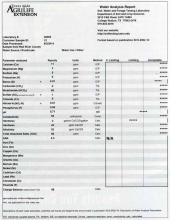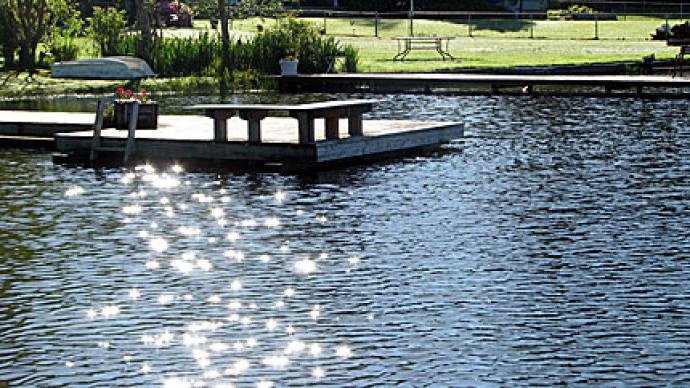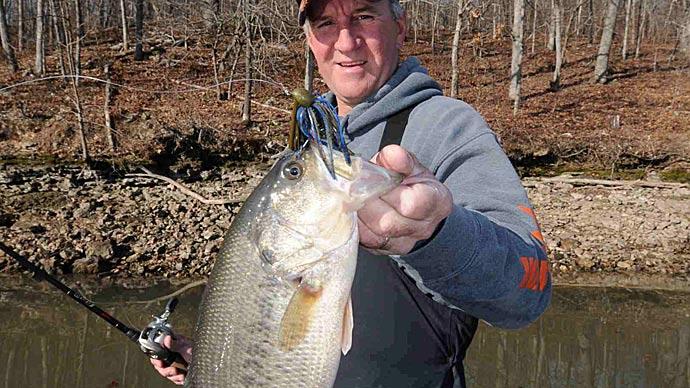Last week, we worked on a beautiful lake, snuggled into a valley in southeastern Oklahoma. As the Dodge Ram pickup truck with the Ranch Hand bumper on front pulled the 18-foot electrofishing boat along the four-wheeler trail, we knocked down brush making room, and in sandy soils, we skirted tall pine trees and snaked around stately oaks. I seriously questioned my ability-—and the truck's turning radius—to get that rig to the water's edge.
The mission? To figure out why there aren't more—and bigger—largemouth bass.
These eager pondmeisters have literally done it by the book. They designed this 18-acre lake, built a good dam, created habitat for their favorite fish, and then stocked the lake at rates any biologist or good angler would appreciate. They started with fathead minnows, bluegills, and red-ear sunfish, just like the book says to do it. When the time was right, they stocked Florida-strain largemouth bass from a reputable dealer. They have a feeder on the dock and decided to fertilize the lake with the appropriate fertilizer in the prescribed amounts at the right time—exactly like they've been taught. They even added threadfin shad in year three, as their bass began to surge toward adulthood.
That's when coontail hit and overtook the pond rapidly. Maybe their fertilization regime and timing was off a little bit? Maybe they inadvertently fertilized this native plant and it became invasive?
They sought good advice, wiped out the coontail, and figured out a strategy to keep it at bay with triploid grass carp. Now, pennywort is warting them and catch rates aren't nearly what they expect. With a young population of fish, and a lake in its fifth year now, standing timber, and a fishy look, it should be a fun place to catch lunker bass and braggin'-sized bluegills. Instead, they've scratched their heads and put the lake in ICU, trying to figure out if it needs CPR.
Improving a pond is like working a jigsaw puzzle. There are lots of pieces to identify, move around, put into place, and arrange to get that puzzle built. While these guys have the picture figured out, they are missing some pieces of this biological puzzle.
As we unloaded the boat, the transom pushed thick mats of pennywort out of the way so we could launch. As we motored out, cranked up the outboard, started the generator, and stepped on the pedal, it was soon obvious this lake's productivity was quite low.
Not many bass, not many sunfish, and slow growth. A year old bass in that lake was a third the size it should be. Relative weights were normal, but a bass that age should be ten inches long. We saw few young fish and very few adults. There were literally acres of habitat for tiny fish. Mats of pennywort made floating islands. Every time the electrodes were pushed into the prime habitat, baby fish should have boiled out like popcorn.
Nothing.
The water was stained the color of my mom's ice tea of my youth — that classic tannic look we see from time to time, especially in areas of acidic soils.
That might be a clue.
As we electrofished the entire periphery and then crisscrossed what little open water there was, dodging stumps, stickups, and mats of plants, it was more apparent that this lake has a productivity problem, not a fish problem.
Even though they've done everything "by the book?"
Yep, even though.
At the end of the survey, all signs pointed to water quality issues as being the culprit of low productivity. We gathered a sample, brought it home, and sent it straight to the lab.
Here's what we found.
pH was 5.7. Calcium was 11 parts per million, which is quite low. Hardness in ppmCaC03 was low, too, at 43. Alkalinity was moderate, at 53 ppm, which didn't make sense to us; it should have measured lower than that, unless there's some biological event we couldn't identify that could artificially push the alkalinity upwards a bit. Bottom line? The water is acidic and doesn't have the mineral base to develop the productivity that lake needs.
Their best choice will be to lime this lake to provide much needed calcium carbonate. For plankton to develop, for fish to build their bone structure, and for the healthiest medium, a pond needs some level of calcium carbonate. Since this lake has measurable amounts of hardness and alkalinity (calcium carbonate) we'll recommend adding more of this key mineral to bring levels up to increase productivity.
How do you know if you should amend your water?
Start by learning what you have and what it means. Water chemistry is hard to understand and amending your water starts with a well-defined mission. Are you nutrient-heavy? Too many plants, too much algae? Want clearer water? Better productivity for fish? Want to drink it, swim in it, or irrigate?
There are lots of ways to improve your water by amending it. You can add lime. Or, gypsum, or aluminum sulfate—but, be careful. If you don't understand the consequences of what you are about to do, you can mess things up.
I'll always remember a good fellow who rang my number. He had bought a contact killer herbicide for an aquatic plant in his pond. He didn't read the restrictions on the label, treated the plants and didn't turn off the irrigation system for his yard. Knocked out the aquatic plants... and most of his yard. In the Midwest and points northward, a common practice is developing to use alum (aluminum sulfate) to bind phosphorus, the key nutrient needed for most aquatic plants to grow. Bind the phosphorus and minimize plant life, if that's the mission.
A golf course used well water to irrigate the greens and fairways. Within a few months, grass looked distressed. Seems there was so much mineral content dissolved in that ground water that it was toxic to the plants. They had to remove the grass and replace much of the soil to fix the problem. What about their well? They pumped water into their adjacent lake, the minerals oxidized and precipitated out and they started irrigating from the lake. It worked well.
Yes, you can amend your water. But, analyze it, first. Ask for help interpreting results so you can see if there's anything wrong with the water in the first place.
For our Okie friends, fertilizer intending to initiate a plankton bloom instead went to feed coontail and now pennywort. Now, they have to contend with another plant to keep it at bay while they decide the best way to amend their water so the fertilizer can do what it's intended to do.
Sometimes, even "the book" doesn't reveal the entire picture of this puzzle we call "pond management."
Reprinted with permission from Pond Boss Magazine




